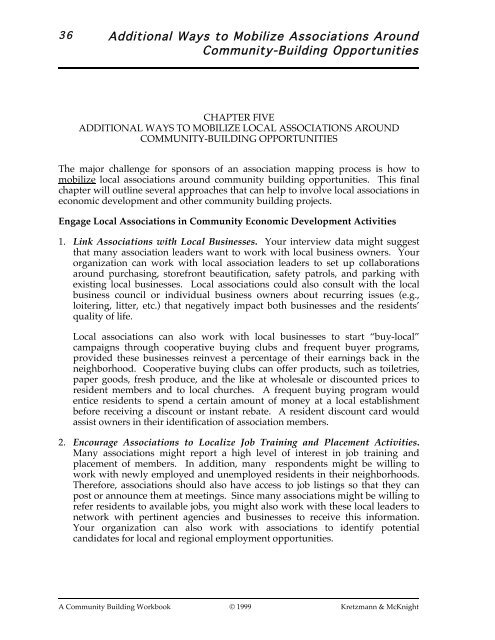A GUIDE TO MAPPING AND MOBILIZING THE ASSOCIATIONS IN LOCAL NEIGHBORHOODS
A GUIDE TO MAPPING AND MOBILIZING THE ASSOCIATIONS IN LOCAL NEIGHBORHOODS
A GUIDE TO MAPPING AND MOBILIZING THE ASSOCIATIONS IN LOCAL NEIGHBORHOODS
You also want an ePaper? Increase the reach of your titles
YUMPU automatically turns print PDFs into web optimized ePapers that Google loves.
36<br />
Additional Ways to Mobilize Associations Around<br />
Community-Building Opportunities<br />
CHAPTER FIVE<br />
ADDITIONAL WAYS <strong>TO</strong> MOBILIZE <strong>LOCAL</strong> <strong>ASSOCIATIONS</strong> AROUND<br />
COMMUNITY-BUILD<strong>IN</strong>G OPPORTUNITIES<br />
The major challenge for sponsors of an association mapping process is how to<br />
mobilize local associations around community building opportunities. This final<br />
chapter will outline several approaches that can help to involve local associations in<br />
economic development and other community building projects.<br />
Engage Local Associations in Community Economic Development Activities<br />
1. Link Associations with Local Businesses. Your interview data might suggest<br />
that many association leaders want to work with local business owners. Your<br />
organization can work with local association leaders to set up collaborations<br />
around purchasing, storefront beautification, safety patrols, and parking with<br />
existing local businesses. Local associations could also consult with the local<br />
business council or individual business owners about recurring issues (e.g.,<br />
loitering, litter, etc.) that negatively impact both businesses and the residents’<br />
quality of life.<br />
Local associations can also work with local businesses to start “buy-local”<br />
campaigns through cooperative buying clubs and frequent buyer programs,<br />
provided these businesses reinvest a percentage of their earnings back in the<br />
neighborhood. Cooperative buying clubs can offer products, such as toiletries,<br />
paper goods, fresh produce, and the like at wholesale or discounted prices to<br />
resident members and to local churches. A frequent buying program would<br />
entice residents to spend a certain amount of money at a local establishment<br />
before receiving a discount or instant rebate. A resident discount card would<br />
assist owners in their identification of association members.<br />
2. Encourage Associations to Localize Job Training and Placement Activities.<br />
Many associations might report a high level of interest in job training and<br />
placement of members. In addition, many respondents might be willing to<br />
work with newly employed and unemployed residents in their neighborhoods.<br />
Therefore, associations should also have access to job listings so that they can<br />
post or announce them at meetings. Since many associations might be willing to<br />
refer residents to available jobs, you might also work with these local leaders to<br />
network with pertinent agencies and businesses to receive this information.<br />
Your organization can also work with associations to identify potential<br />
candidates for local and regional employment opportunities.<br />
A Community Building Workbook © 1999 Kretzmann & McKnight


